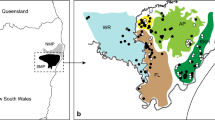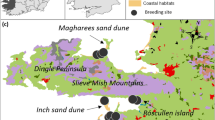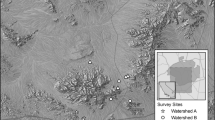Abstract
An understanding of the mean and maximum dispersal distances of target species and subsequent scaling of management efforts to dispersal distance can be key in slowing, containing, or eradicating invasive species. However, dispersal distance is often difficult to measure. Patterns of genetic relatedness can be interpreted to understand realized genetic dispersal distances, which can then be applied to management. We analyzed patterns of microsatellite relatedness using Mantel correlograms and used them to estimate realized dispersal distance for the invasive wetland grass, Phragmites australis. We found that genetic relatedness declined quickly with increasing distance, decreasing to the level of the mean subestuary genetic relatedness by 100 m and to nearly zero by 500 m. We interpret this to indicate that most dispersal is <100 m and very little dispersal extends beyond 500 m. This suggests that management of P. australis may need to consider dispersal from stands up to 500 m from an area that is being managed, perhaps at the scale of whole subestuaries. Results of this study demonstrate that analysis of dispersal patterns can be used to develop landscape-scale approaches to the management of invasive species.


Similar content being viewed by others
References
Albert A, Brisson J, Belzile F, Turgeon J, Lavoie C (2015) Strategies for a successful plant invasion: the reproduction of Phragmites australis in north-eastern North America. J Ecol 103:1529–1537
Auftret AG, Bert J, Cousins SAO (2014) The geography of human-mediated dispersal. Divers Distrib 20:1450–1456
Bruvo R, Michiels NK, D’Souza TG, Schulenburg H (2004) A simple method for the calculation of microsatellite genotype distances irrespective of ploidy level. Mol Ecol 13:2101–2106
Cain ML, Milligan BG, Strand AE (2000) Long distance seed dispersal in plant populations. Am J Bot 87:1217–1227
Clark LV, Jasieniuk M (2011) POLYSAT: an R package for polyploid microsatellite analysis. Mol Ecol Resour 11:562–566
Coutts SR, van Klinken RD, Yokomizo H, Buckley YM (2011) What are the key drivers of spread in invasive plants: dispersal demography or landscape: and how can we use this knowledge to aid management? Biol Invasions 13:1649–1661
Davis HG, Taylor CM, Lambrinos JG, Strong DR (2004) Pollen limitation causes an Allee effect in a wind-pollinated invasive grass (Spartina alterniflora). PNAS 101:13804–13807
Fletcher CS, Wescott DA (2013) Dispersal and the design of effective management strategies for plant invasions: matching scales for success. Ecol Appl 28:1881–1892
Hazelton ELG, McCormick MK, Sievers M, Kettenring KM, Whigham DF (2015) Stand age is associated with clonal diversity, but not vigor, community structure, or insect herbivory, in Chesapeake Bay Phragmites australis. Wetlands 35:877–888
Hamilton MB, Miller JR (2002) Comparing relative rates of pollen and seed gene flow in the island model using nuclear and organelle measures of population structure. Genetics 162:1897–1909
Kettenring KM, McCormick MK, Baron HM, Whigham DF (2011) Mechanisms of Phragmites australis invasion: feedbacks among genetic diversity, nutrients, and sexual reproduction. J Appl Ecol 48:1305–1313
Kirk H, Paul J, Straka J, Freeland JR (2011) Long-distance dispersal and high genetic diversity are implicated in the invasive spread of the common reed, Phragmites australis (Poaceae), in northeastern North America. Am J Bot 98:1180–1190
Kudoh H, Whigham DF (1997) Microgeographic genetic structure and gene flow in Hibiscus moscheutos (Malvaceae) populations. Am J Bot 84:1285–1293
Kudoh H, Whigham DF (2001) A genetic analysis of hydrologically dispersed seeds of Hibiscus moscheutos (L). Am J Bot 88:588–593
Kudoh H, Shimamura R, Takayama K, Whigham DF (2006) Consequences of hydrochory in Hibiscus. Plant Spec Biol 21:127–133
Lambert AM, Casagrande RA (2007) Characteristics of a successful estuarine invader: evidence of self-compatibility in native and non-native lineages of Phragmites australis. Mar Ecol Prog Ser 337:299–301
Lambertini C, Gustafsson MHG, Frydenberg J, Speranza M, Brix H (2008) Genetic diversity patterns in Phragmites australis at the population, regional and continental scales. Aquat Bot 88:160–170
McCormick J, Somes HA (1982) The coastal wetlands of Maryland. Jack McCormick and Associates Inc, Chevy Chase
McCormick MK, Kettenring KM, Baron HM, Whigham DF (2010a) Spread of invasive Phragmites australis in estuaries with differing degrees of development: genetic patterns, Allee effects and interpretation. J Ecol 98:1369–1378
McCormick MK, Kettenring KM, Baron HM, Whigham DF (2010b) Extent and reproductive mechanisms of Phragmites australis spread in brackish wetlands in Chesapeake Bay, Maryland (USA). Wetlands 30:67–74
Pimentel D, Zuniga R, Morrison D (2005) Update on the environmental and economic costs associated with alien-invasive species in the United States. Ecol Econ 52(3):273–288
Raicu P, Staicu S, Stoian V, Roman T (1972) The Phragmites communis Trin.chromosome complement in the Danube delta. Hydrobiologia 39:249–252
Saltonstall K (2002) Cryptic invasion by a non-native genotype of the common reed, Phragmites australis, into North America. Proc Natl Acad Sci USA 99:2445–2449
Saltonstall K (2003) Microsatellite variation within and among North American lineages of Phragmites australis. Mol Ecol 12:1689–1702
Shimamura R, Kachi N, Kudoh H, Whigham DF (2007) Hydrochory as a determinant of genetic distribution of seeds within Hibiscus moscheutos (Malvaceae) populations. Am J Bot 94:1137–1145
Sloop CM, Ayres SR, Strong DR (2011) Spatial and temporal genetic structure in a hybrid cordgrass invasion. Heredity 106:547–556
Soomers H, Karssenberg D, Soons MB, Verweij PA, Verhoeven JTA, Wassen MJ (2013) Wind and water dispersal of wetland plants across fragmented landscapes. Ecosystems 16:434–451
Soons MB (2006) Wind dispersal in freshwater wetlands: knowledge for conservation and restoration. Appl Veg Sci 9:271–278
Taylor CM, Hastings A (2004) Finding optimal control strategies for invasive species: a density-structured model for Spartina alterniflora. J Appl Ecol 41:1049–1057
Telles MPC, Collevatti RG, Braga RS, Guedes LBS, Castro TG, Costa MC, Silva-Junior NF, Barthem RB, Diniz-Filho JAF (2014) Geographical genetics of Pseudoplatystoma punctifer (Castelnau, 1855) (Siluriformes, Pimelodidae) in the Amazon Basin. Genet Mol Res 13:3656–3666
Acknowledgments
We thank Wesley Hauser, Liza McFarland, and Eric Hazelton for help collecting data, the American Chestnut Land Trust for access to Parkers Creek, and the Smithsonian Laboratory of Analytical Biology for running microsatellite samples. This work was supported by award number NA09NOS4780214 from the National Oceanic and Atmospheric Administration (NOAA) Center for Sponsored Coastal Ocean Research (CSCOR).
Author information
Authors and Affiliations
Corresponding author
Additional information
Guest editors: Laura A. Meyerson & Kristin Saltonstall/Phragmites invasion.
Rights and permissions
About this article
Cite this article
McCormick, M.K., Brooks, H.E.A. & Whigham, D.F. Microsatellite analysis to estimate realized dispersal distance in Phragmites australis. Biol Invasions 18, 2497–2504 (2016). https://doi.org/10.1007/s10530-016-1126-1
Received:
Accepted:
Published:
Issue Date:
DOI: https://doi.org/10.1007/s10530-016-1126-1




